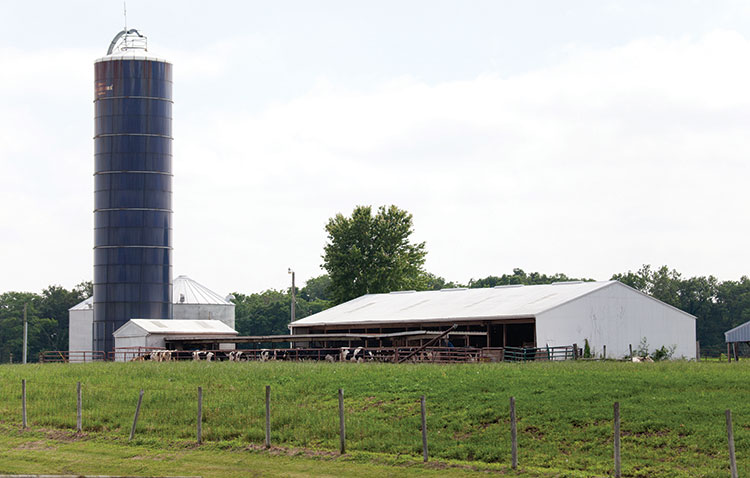
The milk price cycle repeats itself every number of years. While we don’t like it, we’ve come to expect it along with the fact that with each trough more dairy farms will sell the cows and say farewell to the industry. But as we’ve seen over and over, even in a year when low prices make it more difficult for the average dairy farm to stay ahead of the bills, there always seems to be a farm down the street that is not only paying the bills, but is also making a profit.
It’s years such as 2015 that serve as a painful reminder of the boom-and-bust cycle . . . 2015 being the bust and 2014 being the boom. But, amazingly, even though 2014 gave the dairy industry the highest average annual milk price ever, there were still dairy farms that lost money or barely managed to make a profit.
It’s no secret
It’s no secret that dairy farms with similar herd sizes and milk production don’t necessarily enjoy the same financial health. Two farms, for instance, producing 25,000 pounds of milk per cow per year, could differ substantially in their net profits — one dairy making nothing while the other makes over $1,000 per cow per year. And the milk price doesn’t matter.
Between 2014 and 2015 there was a $7 per hundredweight difference in average milk price. Even so, there were dairies that made $1,000 per cow while others lost that much — in each year. Outsiders, unfamiliar with the industry, looking at this data would only shake their heads, wondering what goes on within the sector.
Farm Credit East has been analyzing financial data for dairy farms in New England and New York for over 30 years, summarizing it in their annual Northeast Dairy Farm Summary (DFS). Arguably the most comprehensive analysis of the financial status of dairy farming in the U.S., the DFS has shown us that dairy farm profitability is only minimally influenced by the milk price. The DFS has concluded that, year after year, overall dairy farm management has a much greater impact in determining whether a dairy is profitable in any given year.
Dairy farms that can excel at controlling costs have consistently shown greater profit per cow compared to a dairy that focuses on labor efficiencies or that may receive a better blend price for their milk. Even though milk price does have an impact on profitability, a dairy farm that maintains a low “Net Cost of Production” (NCOP) will have an even greater chance of profitability. There’s also a much closer correlation to profitability with lower NCOP on a dairy than there is to making more milk per cow.
The Farm Credit DFS 2015 data shows that dairy farms that kept their NCOP below $18 per cwt. had a better chance of breaking even or making some money even though the milk price had plummeted from the year before. The DFS indicated that, of the 122 dairies that were in the top quartile, the most profitable were dairies that had the most fiscally conservative management style — also known as “tight with a buck.” This group of dairies averaged a NCOP of $16.52 per cwt.
This took place across the Northeast region where average New England cost of production has been over $20 per cwt. for many years. The net earnings per cow of the financially conservative dairies was well ahead of those that focused on labor efficiencies or maximizing milk production.
In an industry where dairy farmers continue to be “price takers” rather than “price makers,” managing costs becomes an integral part of every production, equipment purchase, or facility design decision. Herd size, housing, and feeding program decisions must now include strategies to keep NCOP as low as possible. At the same time, regardless of milk price, dairy farmers must be saving up for future repairs and maintenance as well as investing in future new technologies.
What a difference a year makes
In 2014, 37 percent of the dairy farms in the DFS study milking between 100 and 299 cows managed a positive 6.4 percent return on assets. In 2015, that same group gave up assets with a -0.6 percent return. (This group also happens to mirror the national average herd size of 212 cows.) As it turns out, in 2015 many dairy farms in New England and New York milking less than 100 cows were more profitable than some dairies milking 100 to 700 cows. So the smaller dairies — even though their numbers continue to dwindle — should not be ruled out as financially viable.
The DFS does show, however, that large herds are consistently more profitable over all sizes of dairies in any given year. It’s becoming increasingly difficult for mid-size herds to remain profitable. This suggests that if dairy farmers are considering expanding their herd size, they must go big so as to attain economies of scale that are less achievable with mid-range herds. However, there will be more financial risk as dairy farmers take on added debt to finance those larger herds.
Back-to-back years — one with record-high prices and the other with more realistic prices — have shown us again that there will always be dairy farmers who lose money. Granted, in years with higher prices, there are fewer farms losing money. However, going forward in this industry, strive for a management strategy focused on fiscal conservation. And while there’s no magic number as to what the debt per cow should be on any one dairy farm, know the limit of debt that can be tolerated and do not let it get out of hand.
A near-term strategy
By all accounts, the rest of 2016 and early 2017 looks like it will be pretty much a repeat of 2015 for prices and margins. Many dairy farms may have gone into 2015 with some extra money left over from 2014, giving them some cushion for the drop in milk price. But that may not be the case in 2016 as the industry copes with a second long year of continuing depressed prices. Sharpening business skills and keeping NCOP as low as possible will become more critical if dairy farmers expect to get through 2016.
The U.S. dairy industry continues to produce more milk than it can ever consume domestically. It’s becoming highly dependent on exports and much more susceptible to the hiccups and vagaries of a global economy. In the current global economy, U.S. dairy farmers have no choice but to compete with lower-priced milk. Maintaining profitability on a dairy farm will require constant monitoring of production costs rather than waiting for that occasional year when the price shoots up.










